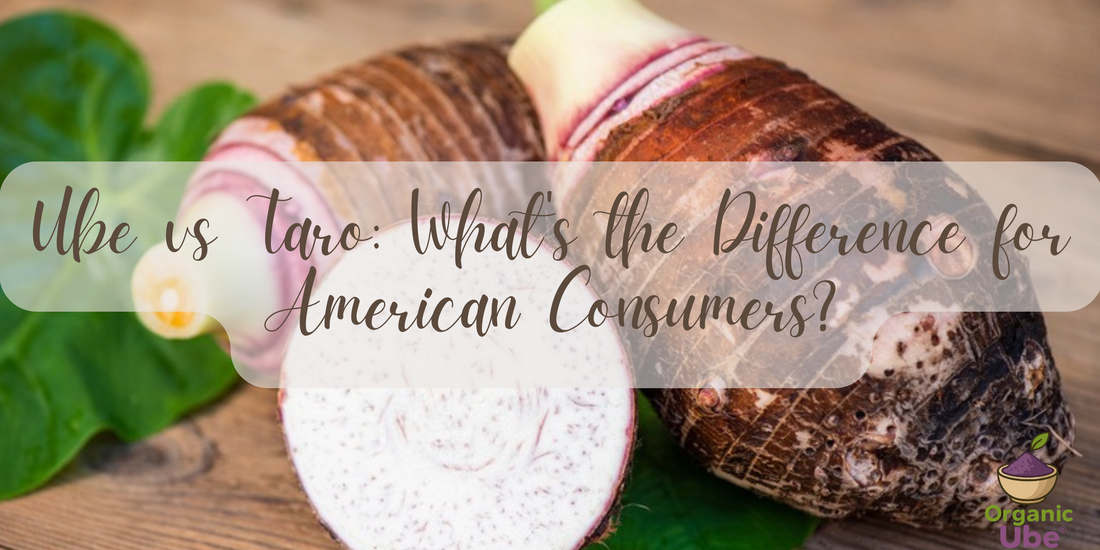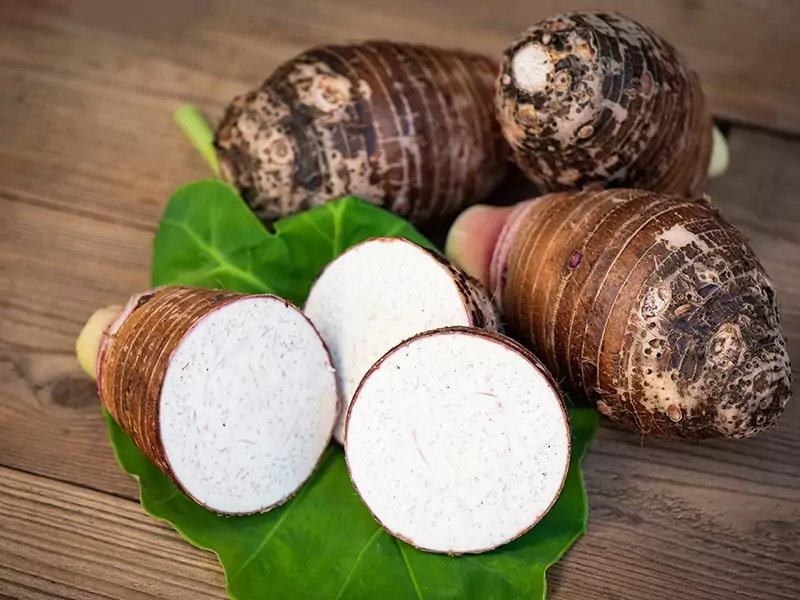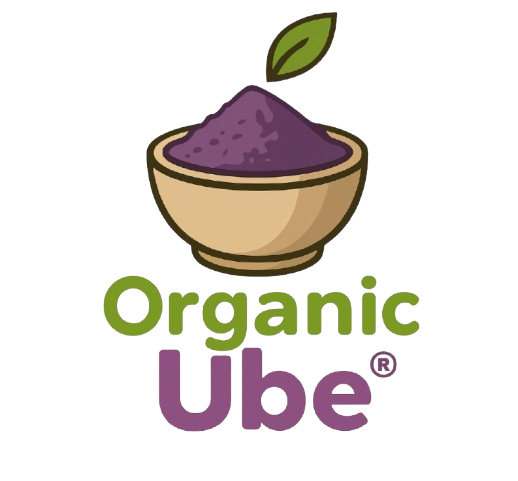
Ube vs Taro: What's the Difference for American Consumers?
Share
If you've been scrolling through social media lately, you've probably noticed a vibrant purple trend taking over your feed. From lattes to desserts, purple root vegetables are having their moment in American cuisine. But here's where it gets confusing: are you looking at ube or taro? 🤔
Before you begin, you can now find all of our UBE products from United States of America by clicking here:
While both deliver that Instagram-worthy purple hue, these two Asian superfoods are actually quite different. Understanding the distinction matters especially if you're looking to enhance your culinary creations or boost your nutritional intake. Let's clear up the confusion once and for all.

What Exactly Is Ube? 🍠
Ube (pronounced "OO-beh") is a purple yam native to the Philippines, scientifically known as Dioscorea alata. This vibrant tuber has been a staple in Filipino cuisine for centuries, traditionally used in desserts like halo-halo and ube halaya.
What sets ube apart is its naturally sweet, slightly nutty flavor with subtle vanilla undertones. When you taste authentic ube, you're experiencing something truly unique a flavor profile that's difficult to replicate with any other ingredient.
The Nutritional Powerhouse You Didn't Know About
Ube isn't just visually stunning; it's packed with nutrients that support your overall wellness:
- Rich in antioxidants: The deep purple color comes from anthocyanins, powerful compounds that help protect your cells from oxidative stress
- High in fiber: Supporting digestive health and helping you feel satisfied longer
- Excellent source of potassium: Essential for heart health and maintaining healthy blood pressure levels
- Contains vitamin C: Supporting your immune system naturally
- Low glycemic index: Providing sustained energy without dramatic blood sugar spikes
Understanding Taro: The Other Purple Root 🌿
Taro (Colocasia esculenta) is a different root vegetable entirely, originating from Southeast Asia and widely used across Asian, Pacific Islander, and even African cuisines. While it can appear purple on the outside, taro's flesh is typically white or pale purple with distinctive purple specks.
How Taro Differs in Taste and Texture
Taro has a more neutral, earthy flavor compared to ube's natural sweetness. Its taste is often described as similar to a potato with subtle nutty notes. The texture, when cooked, is starchy and slightly creamy perfect for savory applications like taro chips, bubble tea, or traditional poi.
Nutritionally, taro offers its own benefits, including resistant starch that supports gut health and a good dose of manganese for bone health.
The Key Differences That Matter to You
Appearance: More Than Just Purple
While both can appear purple, the differences are clear when you know what to look for:
- Ube: Deep, vibrant purple throughout, with a smooth, uniform color that maintains its intensity even after cooking
- Taro: Brownish, hairy exterior with white or light purple flesh containing darker purple flecks or veins
Flavor Profile: Sweet vs. Earthy
This is where the distinction becomes crucial for your recipes:
- Ube: Naturally sweet with vanilla-like notes, making it perfect for desserts, smoothies, and sweet breakfast dishes without added sugar
- Taro: Mild, earthy, and slightly nutty, better suited for both savory and sweet applications but requiring sweeteners for desserts
Culinary Applications: Choosing the Right Ingredient
When to choose ube powder:
- Vibrant purple smoothie bowls and protein shakes
- Naturally sweet desserts like ice cream, cakes, and cookies
- Colorful pancakes and waffles for impressive weekend breakfasts
- Unique lattes and beverages with minimal added sweeteners
- Filipino-inspired traditional desserts
When taro works better:
- Bubble tea and milk teas with a subtle flavor
- Savory dishes and side dishes
- Recipes requiring a more neutral base
- Traditional Asian savory preparations
Why American Consumers Are Choosing Ube Powder ✨

The rising popularity of ube in the United States isn't just about aesthetics though that stunning color certainly doesn't hurt! You're discovering what Filipino families have known for generations: ube offers a unique combination of natural sweetness, nutritional benefits, and versatility.
The Convenience Factor You'll Appreciate
Premium ube powder delivers authentic Filipino flavor without the hassle of sourcing, peeling, and preparing fresh ube root. You get:
- Consistent quality: Every scoop delivers the same vibrant color and authentic taste
- Extended shelf life: No waste from fresh roots going bad before you can use them
- Instant availability: Keep it in your pantry for whenever inspiration strikes
- Easy portion control: Use exactly what you need for each recipe
- Authentic flavor: High-quality ube powder preserves the true taste of fresh ube
How to Use Ube Powder in Your Daily Life 🥄
Incorporating ube into your routine is easier than you might think. Here are some customer-favorite ways to enjoy this purple superfood:
Morning Energy Boosters
Start your day with a vibrant ube smoothie by blending ube powder with banana, coconut milk, and a touch of honey. The natural sweetness means you'll use less added sugar while getting a nutritious breakfast that keeps you energized.
Impressive Desserts Made Simple
Transform ordinary desserts into extraordinary creations. Add ube powder to your favorite cookie dough, cake batter, or frosting recipes. Your guests will be amazed by both the color and the unique flavor profile.
Instagram-Worthy Lattes
Create café-quality ube lattes at home by mixing ube powder with warm milk and a touch of sweetener. It's become a trending favorite for good reason delicious, beautiful, and nourishing.
Navigating Quality: What to Look for in Ube Powder 🔍
Not all ube powder is created equal. As an informed consumer, you deserve to know what separates premium products from inferior alternatives.
Red Flags to Avoid
Artificial coloring: Some products use dyes to achieve that purple color rather than real ube. Check ingredient lists carefully.
Excessive fillers: Lower-quality powders may contain maltodextrin or other fillers that dilute the authentic ube content.
Lack of transparency: Reputable brands clearly state the source and processing methods of their ube powder.
What Premium Quality Looks Like
Look for ube powder that:
- Lists ube (Dioscorea alata) as the primary ingredient
- Uses minimal, recognizable ingredients
- Comes from trusted sources in the Philippines
- Maintains that characteristic vibrant purple color
- Dissolves smoothly without clumping
The Cultural Significance Worth Celebrating
When you choose authentic ube, you're not just buying an ingredient you're supporting Filipino culinary heritage. Ube represents generations of tradition, family recipes, and cultural pride. By bringing ube into your kitchen, you're participating in a beautiful cross-cultural exchange.
This matters more than you might realize. Supporting authentic ingredients helps preserve traditional farming practices and provides economic opportunities for Filipino communities who have cultivated ube for centuries.
Making the Right Choice for Your Kitchen
Now that you understand the difference between ube and taro, you can make informed decisions for your culinary adventures. While taro certainly has its place in Asian cuisine, ube offers something special for American home cooks and health-conscious consumers.
The Bottom Line
Choose ube when you want:
- Natural sweetness that reduces the need for added sugars
- Authentic Filipino flavor and cultural experience
- Maximum visual impact with that stunning purple color
- Superior nutritional benefits from antioxidant-rich anthocyanins
- Versatility in sweet applications without compromise
Consider taro when you want:
- More neutral flavor for savory dishes
- Traditional bubble tea preparations
- A potato-like base for various applications
Your Next Steps to Ube Excellence 💜
Ready to experience the magic of authentic ube? Here's how to get started:
- Start simple: Try adding ube powder to your morning smoothie or oatmeal
- Experiment gradually: Once comfortable, branch out to baking and desserts
- Share the experience: Ube creations are meant to be enjoyed with others
- Store properly: Keep your ube powder in an airtight container away from direct sunlight
Frequently Asked Questions

Is ube powder as nutritious as fresh ube?
Quality ube powder retains most of the nutritional benefits of fresh ube, including antioxidants and fiber, while offering superior convenience and consistency.
Can I substitute taro powder for ube powder?
While you can make this substitution, the flavor profile will be significantly different. Taro lacks ube's natural sweetness and distinctive taste, so your recipe results will vary considerably.
How much ube powder should I use?
Start with 1-2 tablespoons per serving for beverages and smoothies, adjusting based on your color and flavor preferences. For baking, follow specific recipe guidelines or substitute 10-15% of your flour with ube powder.
Does ube powder expire?
When stored properly in a cool, dry place, quality ube powder maintains its potency for 12-18 months. Always check the package date and look for any changes in color or smell.
Embrace the Purple Revolution
The distinction between ube and taro matters because you deserve authentic ingredients that deliver real results. Whether you're a home baker looking to impress, a health-conscious smoothie enthusiast, or someone who simply appreciates unique flavors, ube powder opens up a world of delicious possibilities.
You now have the knowledge to navigate the purple root vegetable landscape with confidence. The vibrant world of ube awaits your taste buds (and Instagram followers) will thank you. 🌟
Ready to experience the authentic taste of Filipino purple yam? Discover why thousands of American home cooks have made premium ube powder their secret ingredient for creating memorable, nutritious, and absolutely stunning dishes.
👉Order your 100% natural organic ube powder at ube.com
👉 Explore our healthy recipes and join the community of ube enthusiasts!
👉 Subscribe to our newsletter to receive our ube tips and inspiration every week.








